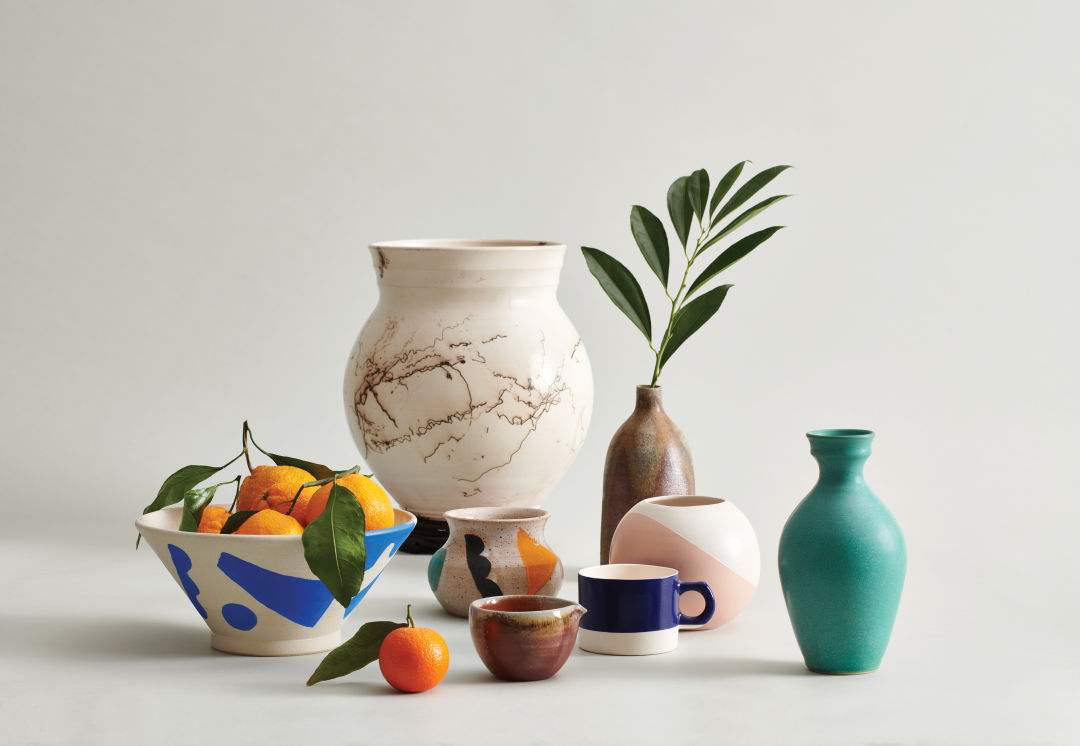Seattle Potters Spin Stylish Ceramics

Clockwise from far left, ceramics by Burton, Yu, Alphonse, Karpoff, Yu, Karpoff, Alphonse, and Burton.
Image: Justin Gollmer
Be they thrift store finds, containers of sentimentality, or keepsakes covered in bad puns or proclamations of being the world’s best someone, mugs are like personal style statements you hold in your hand. When making such an everyday item, Tesha Karpoff is constantly “figuring out new ways of pushing the porcelain.” The self-taught potter marries utility with aesthetic appeal: “I’m creating mostly useful objects,” she says, thinking about “how they work as a set, with food and drink, or liquid if it’s a vase.” The same goes for her ceramic plates, platters, clay planters, that pretty dish on your dresser holding life’s forgotten contents (loose change, an old mail key, two-year-old receipts).
While pottery is thousands of years old, local ceramists like Karpoff are shaping, truly, a recent trend. In homes, cafes, and even restaurants, plain white dinnerware sets make way for hand-thrown clay with visual idiosyncrasies. At Sea Wolf Bakers in Fremont, Karpoff’s minimalist, Aegean-blue mugs hold drip coffee for bakery-goers. Meanwhile, Damon Burton of Slip Ceramica is a painter-turned-potter who applies geometric shapes and a modern color palette—far removed from the natural brown tones in vogue 50 years ago—to one-of-kind mugs and planters that he sells at craft fairs. At her studio east of SoDo Natasha Alphonse makes ceramics that have a refined rusticity, inspired by her upbringing on a Dene tribal reservation in Saskatchewan—“lots of mossy rocks and huge expanses of white, frozen lakes.”
Even the tableware can help deliver a unique dining experience. Maximillian Petty, chef and owner of Eden Hill on Queen Anne, has an extensive collection of 500 plates for his quaint 26-seat restaurant. He admits he’s obsessed when it comes to plating. Petty likens it to writing a menu: Go to the market, find local things. It was at a market in Ballard where he stumbled upon Curtis Yu’s pottery.
“A chef’s dream is an earth-toned, simple canvas that’s not grossly stark white,” says Petty. For this, Yu’s plates are ideal. At the artist’s Greenwood gallery and studio, though, his style varies: “I’m really influenced by my Chinese heritage...from calligraphy brushwork to carved motifs.”
Seattle’s long been a hub for pottery. Institutions like Seward Park Clay Studio and Pottery Northwest have been around since the ’60s and ’70s. But, says Karpoff, “there’s definitely a shift from the heavily glazed, funky, sturdy pottery that was probably really big in the ’70s.”
What hasn’t fundamentally changed about clay, she notes, is “getting your hands dirty and flinging mud all over the place.”
Meet the Talent

From left to right, Tesha Karpoff, Curtis Yu, Natasha Alphonse, and Damon Burton.
Image: Elizabeth Podlesnik
Tesha Karpoff
The porcelain pusher molds her minimalist vases and mugs outside of Bellingham, but find her work at Liten in Fremont or Sea Wolf Bakers. lepusstudiosart.com
Curtis Yu
A co-op studio and gallery in Greenwood houses Yu Tang Ceramics: Teal-glazed cups, wood-fired mugs, big, shapely vases. yutangceramics.com
Natasha Alphonse
Raised on a tribal reservation, the native artist is especially inspired by her natural environment—most notably rock colors and formations. alphonsestudio.com
Damon Burton
The ceramist’s colorful, graphic approach speaks to his time as a painter and his Mexican heritage from which traditional pottery is likewise vibrant. seattlepopupmarkets.com/blog/slip-ceramica




